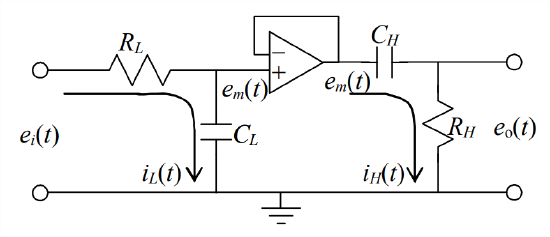10.4: Frequency-Response Function of an RC Band-Pass Filter
- Page ID
- 7687
We re-visit once again Section 5.4 and the example of Section 9.10, where it is demonstrated that a typical \(RC\) band-pass filter, as depicted below, is an overdamped 2nd order system with right-hand-side dynamics. Our goal now is to derive the FRF of this filter circuit. Rather than analyze 2nd order ODE 9.10.9 directly, it is instructive to start with the coupled 1st order ODEs of the two stages: Equation 5.4.1, \(\tau_{L} \dot{e}_{m}+e_{m}=e_{i}\), with \(\tau_{L}=R_{L} C_{L}\), for the upstream, low-pass filter; and Equation 5.4.2, \(\tau_{H} \dot{e}_{o}+e_{o}=\tau_{H} \dot{e}_{m}\), with \(\tau_{H}=R_{H} C_{H}\), for the downstream, high-pass filter. In this approach, we represent a system (the band-pass filter, in this case) as an assemblage of stages or lower-order sub-systems (the low-pass and high-pass filters, in this case). This section is a preview of the more general discussion beginning in Chapter 13.

Taking the Laplace transform of the ODE for the low-pass stage, with the assumption that all ICs are zero, gives
\[\left.\left(\tau_{L} s+1\right) L\left[e_{m}\right]\right|_{I C s=0}=\left.L\left[e_{i}\right] \Rightarrow L\left[e_{m}\right]\right|_{/ C s=0}=\frac{1}{\tau_{L} s+1} L\left[e_{i}\right]\label{eqn:10.25} \]
Next, we take the Laplace transform of the ODE for the high-pass stage, still with the assumption that all ICs are zero, and then substitute Equation \(\ref{eqn:10.25}\) into the result:
\[\left(\tau_{H} s+1\right) L\left[e_{o}\right]_{/ C s=0}=\left.\tau_{H} s L\left[e_{m}\right]\right|_{I C s=0} \nonumber \]
\[\left.\Rightarrow \quad L\left[e_{o}\right]\right|_{I C s=0}=\left.\frac{\tau_{H} S}{\tau_{H} S+1} L\left[e_{m}\right]\right|_{I C s=0}=\frac{\tau_{H} s}{\tau_{H} s+1} \times \frac{1}{\tau_{L} s+1} L\left[e_{i}\right]\label{eqn:10.26} \]
So the transfer function of the entire \(RC\) band-pass filter circuit, clearly displaying right-hand-side dynamics, is
\[T F(s) \equiv \frac{\left.L\left[e_{o}\right]\right|_{I C_{s=0}}}{L\left[e_{i}\right]}=\frac{\tau_{H} s}{\left(\tau_{H} s+1\right)\left(\tau_{L} s+1\right)}\label{eqn:10.27} \]
Finally, the system complex frequency-response function is
\[F R F(\omega)=T F(j \omega)=\frac{j \omega \tau_{H}}{\left(j \omega \tau_{H}+1\right)\left(j \omega \tau_{L}+1\right)}\label{eqn:10.28} \]
See homework Problem 10.11 for a numerical evaluation of this frequency response that demonstrates the practical function for which a band-pass filter is designed.


